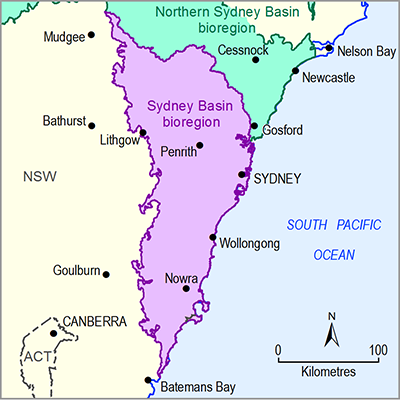In the earliest Permian, the Sydney Basin (as currently defined) did not exist, although deposition of the basin’s lowermost stratigraphic units had begun as early as the Late Carboniferous (Brakel, 1991, p. 12). This deposition took place in the north and south of the basin in fluvial and lacustrine environments (Brakel, 1991, p. 12). This is not to say that structural features of the basin did not exist in the early Permian; for example, the volcanic rift along the Lapstone Fault (a basement feature) was forming even then, but the main period of activity occurred in the late Permian (Harrington and Brakel, 1981; Harrington and Brakel, 1991, p. 206). A depositional hiatus (forming a widespread disconformity) across the Sydney Basin has been attributed to tectonic movement that later resulted in the marine transgression event of the early Permian (Brakel, 1991, p. 13). Depositional settings were largely controlled by the marine transgression and regression cycles that directly impacted the basin (Herbert, 1997; O’Neill and Danis, 2013). These continual large and small cycle sea-level changes resulted in the formation and distribution of the marine, fluvial and deltaic environments that were the dominant environmental settings for the basin (Herbert, 1997).
The SGBB overlies and is bounded by the series of older geological domains (fold belts) collectively known as the Tasman Fold Belt (O’Neill and Danis, 2013). The Tasman Fold Belt contains the Ordovician to early Cretaceous rocks of the Delamerian Orogen, Lachlan Fold Belt, New England Fold Belt, Thomson Fold Belt and Kanmantoo Fold Belt (O’Neill and Danis, 2013). The evolution of these fold belts began in the Mesoproterozoic during breakup of an older supercontinent, and were further influenced during middle Cambrian development of a passive and a convergent margin system, and subsequently by the Carboniferous formation of Pangaea and the earliest signs of the Pangaea breakup (Veevers, 2000; O’Neill and Danis, 2013). Sitting to either side of the Sydney Basin are two of the five tectonic realms of the Tasman Fold Belt, the New England Fold Belt to the north and north-east and the Lachlan Fold Belt to the west and south-west (Scheibner, 1978; Powell et al., 1990). The rocks of the Tasman Fold Belt have been directly linked to the SGBB as a sediment source (O’Neill and Danis, 2013). The dominant structural features of the Sydney Basin are aligned in the direction of the underlying rift deformation, north-east to south-west (Korsch et al., 2009; Haworth, 2003).
The earliest structural development of the SGBB took place in the Middle Devonian, with the formative beginning of two elements of the Tasman Fold Belt, the Lachlan Fold Belt and the Kanmantoo Fold Belt. This early phase of development of the Tasman Fold Belt ceased in the early Carboniferous (Scheibner, 1999, p. 26). Also occurring around this time was subsidence‑related volcanic activity within the area of the proto New England Fold Belt (Scheibner, 1999, p. 26). Plate interactions generating orogenic events in the vicinity of the New England Fold Belt, and parts of the Lachlan Fold Belt, resulted in loading and flexure that led to the depressed structural feature that eventually evolved into the SGBB (Scheibner, 1999, p. 26).
During the middle to Late Carboniferous, uplift, faulting, crustal block rotation and extension related to the Hunter-Bowen Orogeny (super cycle 2) resulted in crustal extension to form the first major depression of the Sydney and Gunnedah basins (Tadros, 1995, p. 166; O’Neill and Danis, 2013). For more detail on super cycles see O’Neill and Danis, 2013, pages 7 to 10.
In the Late Carboniferous, in cycle 3 of the Hunter-Bowen Orogeny, the extension of the crust resulted in major rift events affecting the areas of the Bowen and Sydney basins (O’Neill and Danis, 2013). The bulk of the SGBB formation began at some stage between 300 and 268 million years ago in the Late Carboniferous to early Permian when rifting resulted in an elongated area of deposition for some glacially derived sedimentation, though earlier formation had occurred (Tadros, 1995, p. 166; O’Neill and Danis, 2013). Following this period of rifting, volcanic activity in the early Permian formed the base of the Sydney Basin as seafloor spreading and westward subduction took place (O’Neill and Danis, 2013). For the remaining middle Permian and into the late Permian, cycle 3 of the Hunter-Bowen Orogeny continued to form the SGBB as compression and large scale folding resulted in the north to south deformation of the basins (to resemble their modern structural assemblage) and the deposition of the Greta Coal Measures (O’Neill and Danis, 2013).
During the late Permian, as part of the fourth cycle of the Hunter-Bowen Orogeny the SGBB was subject to compression and crustal loading due to convergence. This resulted in development of foreland basins, rather than rift basins (O’Neill and Danis, 2013). At this time coal deposition was widespread throughout the SGBB, with the bulk of the source rock originating from the Tasman Fold Belt (Scheibner, 1999, p. 28; O’Neill and Danis, 2013). In the Lower Triassic, sedimentary deposition was dominated by fluvial transport during a period of continued plate convergence and tectonic uplift (O’Neill and Danis, 2013). Towards the final stage of the Hunter-Bowen Orogeny, continued collision and uplift completed sedimentation of the basins as major faulting activity brought about folding, and built the dominant anticline and syncline structures (O’Neill and Danis, 2013).
Rifting of Pangaea resulted in the reactivation of older features and volcanic eruptions within the Sydney Basin (O’Neill and Danis, 2013). The last major phase of tectonic activity which affected the Sydney Basin occurred over 150 million years ago (Wellman, 1987; Haworth, 2003). The Sydney Basin is now regarded as being tectonically stable (Haworth, 2003).

